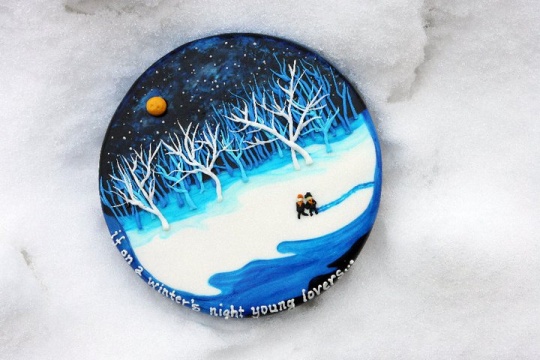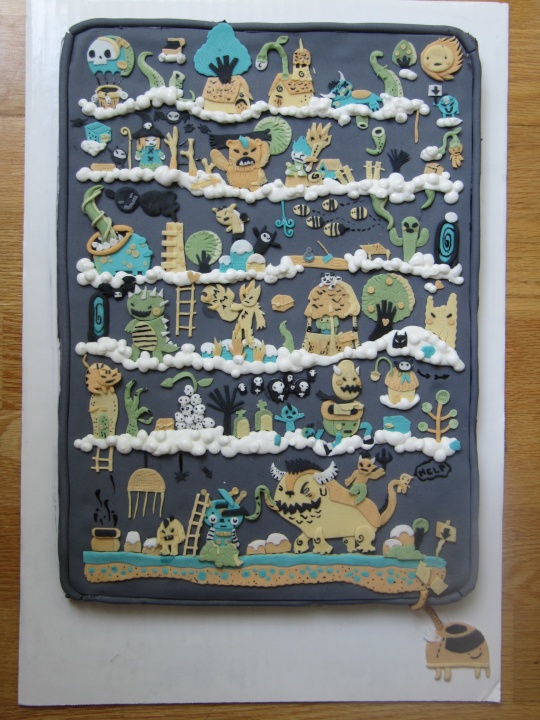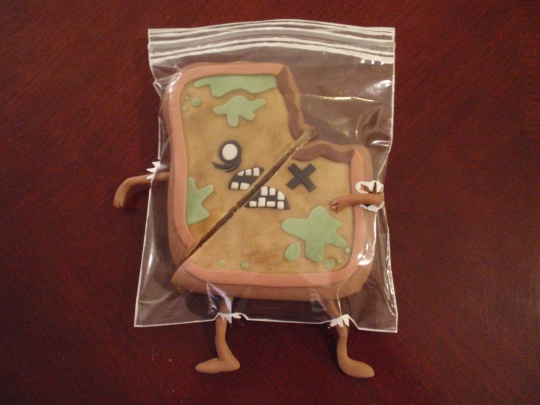I've got a new focus for the blog (and from the sounds of it, you're all down too): recipe development. It's something I've been really into lately, and I firmly believe that coming up with your own recipes (which actually work and taste great) is something everyone can do without spending hours and hours on them. So right now, we're digging into cakes! I posted a little bit about this a few days ago in my
Chocolate Zucchini Cake post, but I'd like to go into a bit more, and look at another cake formula which follows the same rules.
We'll go on to look at other types of cake later, but for now, we'll master the classic butter cakes. Pound cake, "shortened" cakes, and most other cakes that use the creaming method fit in this category.
Flour:
I always start a recipe with flour. For two cakes 9 inch rounds, I usually start with 2 cups of flour. Flour, in the world of cake ingredients, is known as a drier. This means that it gives structure and body to a cake. In the world of cake ingredients, there are also other common driers. Specifically things like cocoa powder. Because they behave similarly, you can substitute other driers for part of your flour in a cake. It is important to do exactly that, though, and substitute. If you simply add cocoa powder to the 2 cups of flour you need for two 9 inch rounds, you'll end up with dry, tough cake. But if you follow the rules and use 2 cups of driers, you can substitute no problem. (Note: You still need to use a good amount of flour itself, however, for structural purposes.) The driers are also the one set of ingredients in cakes that you need to know both the weight and volume of.
(Note: In an ideal world, we'd all use cake flour for almost every cake, but I do realize that many of us don't really have access to it, and many of us don't like to keep uni-taskers (to borrow from Alton Brown) around. Your cake should turn out no matter which flour you use.)
Other Dry ingredients:
When I say other dry ingredients, I really mean leaveners and salt. The leaveners are the reason it is important to know the volume of the flour. To leaven one cup of flour, you need about 1 1/4 tsp of baking powder, or 1/4 tsp of baking soda. My leavener of choice is usually baking powder, unless I'm making something like a lemon cake, where I want the flavor of lemons to shine through without so much acid. Then I use baking soda, because it counteracts some of the acid in a cake. Salt is a bit more of a grey area. I usually add somewhere between 1/4 tsp and 1/2 tsp for two cups of flour, depending on the flavor of the cake. Salt in a sweet brings the flavors to the perfect level for our taste buds. Salt adds a lot to caramel or chocolate flavor, but too much salt is easily tasted in flavors like vanilla.
Sugar:
In a cake made by creaming butter and sugar together, sugar plays a greater role than just sweetening and tenderizing. Sugar is needed to trap air bubbles in the butter, which gives the cake part of its leavening. For this reason, a good amount of granulated sugar is needed. Some honey, molasses, etc can be substituted, but not much. For this style of cake, the total amount of sugars (granulated or liquid) should be equal to or slightly less than the weight of the driers.
Eggs:
Eggs play a few different roles in cake balancing. the give structure, they moisten, they tenderize, and they leaven. The nice thing about eggs in a cake recipe is that you don't have too much choice. The weight of the eggs and the liquid combined should be equal to the weight of the driers. In this case that would mean about six eggs is equal to the weight of flour for two 9 inch rounds. But to add this many eggs would mean that you could add no liquid. Normally I try keep eggs at no more than 50% of the weight of the flour, because otherwise you have a very thick batter and are likely to get too tough of a case.
Liquid:
Using the rule of liquids and eggs combined weighing as much as the flour, the liquid is then easy to figure out by subtracting the weight of the eggs from the weight of the flour. Common liquids for cakes are milk, buttermilk, and sour cream, but get creative! This is a great place to introduce flavors.
Butter:
Shortening is definitely NOT an option. But the amount of butter is easy to figure out, too. The weight of the butter in a cake recipe should be equal to the weight of the eggs.
And it really is that simple. Cream together the butter and sugar, add the eggs, and alternately mix in the dry ingredients and liquids. It'll take you maybe 5 minutes to write your own cake recipe using this method. I don't know about you, but I've spent a lot longer searching blogs for cake recipes.
So here's an example recipe that I came up with while writing this post. They're s'mores cupcakes, before summer ends and we all move on to holiday desserts.
Recipe:
- 1 1/2 cup flour
- 3 graham crackers (this comes out to 1/2 cup graham cracker crumbs)
- 2 1/2 tsp baking powder
- 1/4 tsp salt
- 5 oz butter, softened
- 6 oz granulated sugar
- 2 oz brown sugar
- 3 eggs
- 4 oz milk
- 1 tsp vanilla
- 1/2 oz honey
- 3 oz chocolate chips
- 3 egg whites
- 3/4 cup granulated sugar
Directions:
- Preheat the oven to 350 degrees F.
- In a food processor, process the graham crackers until they are a fine powder.
- Whisk together the flour, graham crackers, baking powder, and salt.
- Cream together the butter and sugars until light and fluffy.
- Add the eggs to the butter, one at a time, scraping the bowl between additions.
- Add half of the dry ingredients and beat until just combined, then alternate in the wet ingredients (milk, vanilla, and honey) with the rest of the dry ingredients. Mix in the chocolate chips and spoon into prepared cupcake tins.
- Bake for approximately 15 minutes and allow to cool.
- Over a double boiler, gently stir together the egg whites and 3/4 cup sugar until they reach 140 degrees. Then transfer to a mixer and beat until stiff peaks form.
- Pipe meringue onto cooled cupcakes and toast with a torch.
Texture-wise, the cakes turned out great. Taste-wise? Equally great. I would probably up the amount of brown sugar and lower the granulated a bit, as well as put a little more graham cracker instead of some of the flour, but I had a hit (according to my wonderful fiance [yes, I still pretend her opinion is unbiased]) the first time around. So please, friends, next time you go to make a cake or cupcakes, try this out! Then comment and let me know how it went for you.

Anything you're confused about?
Any special topics you'd like to see in future recipe-development posts?
Share on Tumblr

and preheat the open to 300 degrees F.












































